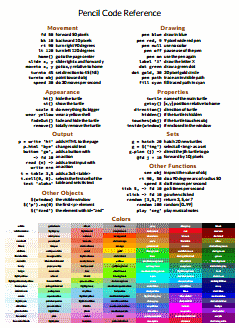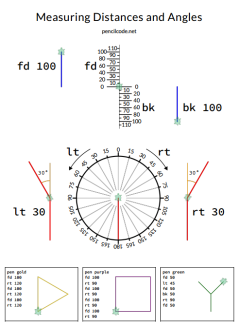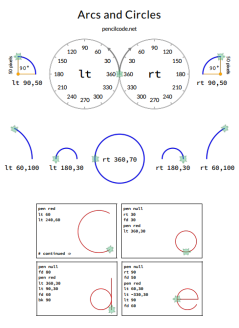
Pencil Code Online Guide



 This page collects together useful reference materials
and examples. If you have ideas for other good material for this
page, post them on the
discussion group so
that they can make their way into this area.
Pencil Code is free to use, but there are some community
guidelines. Check out the terms of service
and privacy policy, and take a look at the
overview video.
This page collects together useful reference materials
and examples. If you have ideas for other good material for this
page, post them on the
discussion group so
that they can make their way into this area.
Pencil Code is free to use, but there are some community
guidelines. Check out the terms of service
and privacy policy, and take a look at the
overview video.
Many printable classroom materials are gathered on
activity.pencilcode.net. Here is a
Quick
Reference Sheet summarizing Pencil Code functions, and here is a brief
CoffeeScript
Language Reference.
When learning about angles and turtle graphics,
print out these reference sheets on
Measuring Distance and Angles and on
Arcs and Circles.
This Learn to Program with CoffeeScript
tutorial introduces the basic concepts of Iced CoffeeScript by working
on a single project. At the end of the two-hour tutorial, you have built a hangman
game that uses variables, computer arithmetic, looping and conditionals,
graphics, synchronization, and networking.
For teachers using Pencil Code to provide a elements of a full introduction
to programming, the Pencil Code Teaching
Manual provides twelve chapters of examples, explanations, and sample
lesson plans on how Pencil Code can be used to cover topics from
I/O, to Netsted Loops, to Recursion, to jQuery. The manual is freely
available as printable PDFs.
There are many other resources for learning about CoffeeScript.
The book Smooth
Coffeescript by E. Hoigaard is a good book oriented
towards new programmers.
If you would like a video lecture, here
here
is a video course from Code School that is oriented towards
students who already know some programming. The O'Reilly book
Little Book on CoffeeeScript by Alex MacCaw
is a svelte 62 pages. This
slide
deck from Aseem Kishore covers the language pretty thoroughly.
If you are looking for a cookbook
with ideas for small pieces of code, take a look at
the CoffeeScript Cookbook
online, or explore the examples below.
The examples below are fit for brief explorations. A
paperback guide
that includes color illustrations for each example is
available on Amazon or as a pdf.
- Lines.
Programming with sequences and lines and curves.
First
Video,
Worksheet.
Angles video.
- Points.
Dots, labels, variables and basic debugging techniques.
- Loops.
Using the
for statement to repeat code.
- Nesting.
Nesting loops to build beautiful effects.
- Functions.
Using
-> to define your own functions.
- Parameters.
More powerful uses of function parameters.
- Time.
Repeating code using a simple
tick timer.
- Output.
Using
write and HTML and CSS for output.
- Input.
Using
read and button for input.
- Numbers.
How to use numbers for counting and calculation.
- Computation.
Examples of more complex mathematical computations.
- Objects.
Making and using objects with several properties.
- Arrays.
Arrays are for sequences and vectors and stacks.
- Recursion.
Recursive functions call themselves and can make amazing effects.
- Concurrency.
Race conditions, shared memory, message passing.
- Sets.
Multiple turtles and jQuery sets.
- Motion.
Simulating motion with velocity, gravity, and physics.
- Networking.
Using resources on the web.
- Intelligence.
Artificial intelligence, reasoning, and backtracking.
 This page collects together useful reference materials
and examples. If you have ideas for other good material for this
page, post them on the
discussion group so
that they can make their way into this area.
Pencil Code is free to use, but there are some community
guidelines. Check out the terms of service
and privacy policy, and take a look at the
overview video.
This page collects together useful reference materials
and examples. If you have ideas for other good material for this
page, post them on the
discussion group so
that they can make their way into this area.
Pencil Code is free to use, but there are some community
guidelines. Check out the terms of service
and privacy policy, and take a look at the
overview video.
